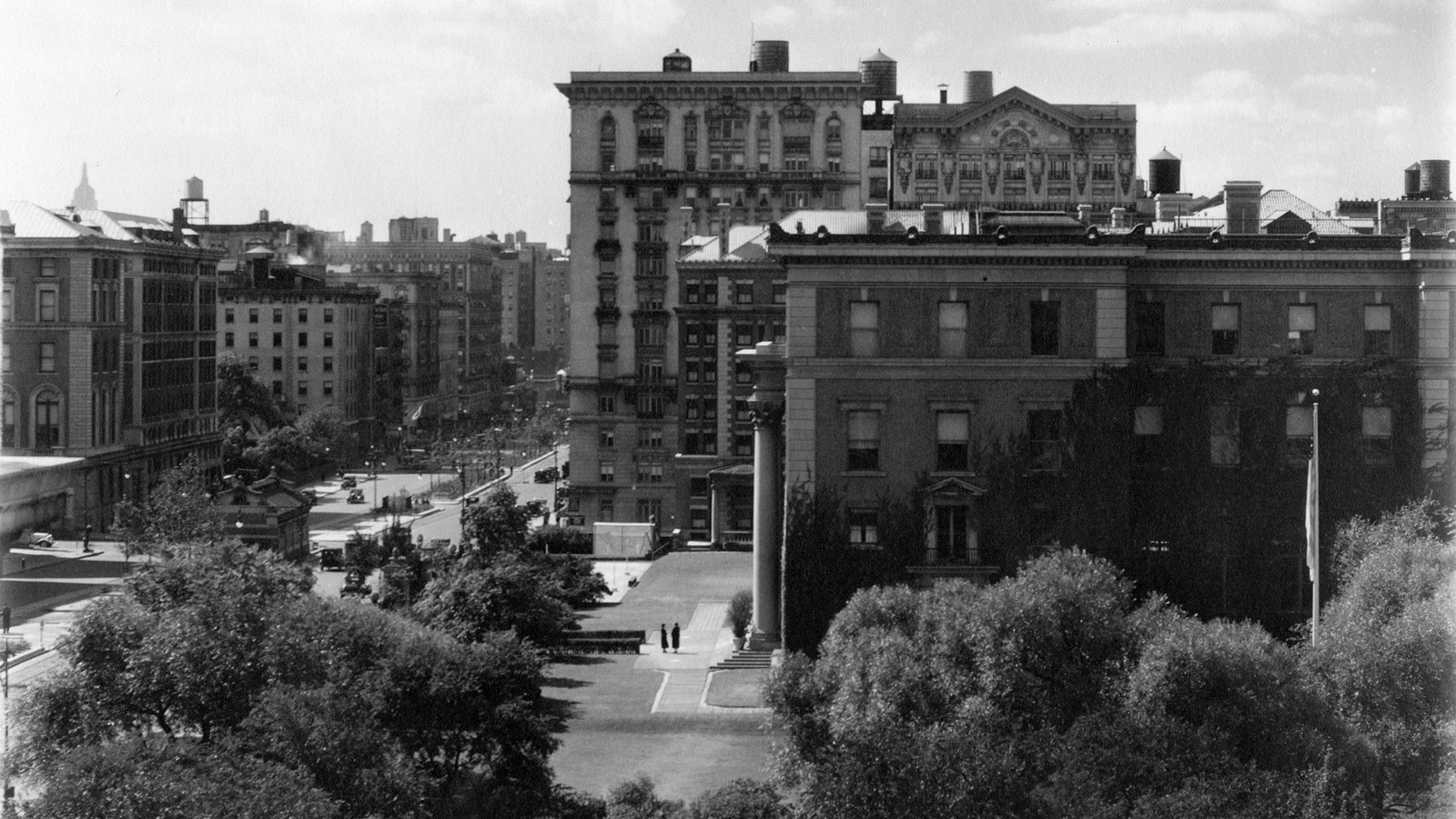Last updated: March 24, 2021
Place
Barnard Hall at Barnard College

http://digitalcollections.barnard.edu/islandora/object/islandora:406
by Jade Ryerson
Students’ Hall was erected in 1916 and opened the following year on Barnard College’s campus in New York City. The building was renamed for Frederick A. P. Barnard, Columbia University’s tenth president who repeatedly advocated for women’s admission to the university. While women were barred from attending Columbia’s various colleges into the first half of the 1900s, Barnard College was founded in 1889, as an affiliated college for women.
Committed to women’s education, Barnard College provided its students with opportunities for involvement and activism from its outset. Barnard later merged with Columbia University, allowing access to Columbia’s resources while maintaining its identity as a smaller institution. Barnard’s mission is largely reflected in the pursuits of alumni, such as Mabel Ping-Hua Lee.
Mabel grew up in Guangzhou with her mother and grandmother, where she attended missionary school and learned English. After winning a Boxer Indemnity Scholarship, Mabel, along with her mother, immigrated to the United States in 1905 to study and join her father in New York City. By the time she was a teenager, Mabel became an active member in the women’s suffrage movement, attending parades and events and writing for publications. A year after riding on horseback in the 1912 New York City women’s suffrage parade on Fifth Avenue, Mabel began studying at Barnard College. She pursued her interests in education, political engagement, and women’s rights through her studies and activities.
Mabel studied the history of women’s education and began drafting feminist essays advocating for women’s rights. In 1913, one of these publications, “The Meaning of Woman Suffrage” was published in Chinese Students’ Monthly by the Chinese Students’ Alliance of the United States of America. Mabel was a prominent member in this organization and at one point ran for president. While at Barnard, she also joined the Philosophy Club, where she was elected Treasurer and then President. She participated in the Young Woman’s Christian Association, as well, and was a member of the Silver Bay Girls (having attended a conference at the YMCA Silver Bay campus on Lake George, New York). These activities reflected Mabel’s devotion to her faith and community.
After her graduation in 1916, Mabel continued to support the suffrage movement, supporting the Women’s Political Equality League, encouraging the involvement of other Chinese women through her writing, and marching in the 1917 women’s suffrage parade in New York City. Although women gained the right to vote in New York in 1917, Mabel remained unenfranchised even after the ratification of the 19th Amendment in 1920. The Chinese Exclusion Act of 1882 barred Mabel and other Chinese immigrants from citizenship and voting until the Act’s repeal in 1943.
Although “Students’ Hall” did not open until 1917, after Mabel had graduated, she and other students were likely excited about the new building about the new building following its proposal in 1915. Student publications including The Mortarboard yearbook and The Barnard Bulletin wrote about the proposal and subsequent erection of a new students’ building. The 1916 and 1917 editions of The Mortarboard even featured sketches of the structure from The New York Tribune and the architects Arnold W. Brunner and Associates.
Floor plans from the architects depict a gymnasium, a stage, a conference room, offices for students, faculty, and administrators, a kitchenette, lunchrooms for the faculty, deans, servants, and students, class study rooms, a kitchen, and ice cream and pastry rooms. The building itself encompasses seventy-nine thousand square feet including classrooms, Public Safety, the Fitness Center, Sulzberger Parlor, and the James Room. Barnard Hall was listed in the National Register of Historic Places on November 15, 2003.
Bibliography:
Barnard College. “A Fearless History.” Boldly Barnard. Accessed December 10, 2019. https://barnard.edu/boldly-barnard/fearless-history.
———. “The College and its Mission.” Boldly Barnard. Accessed December 10, 2019. https://barnard.edu/college-and-its-mission.
———. “From the Group Up.” News. Published November 1, 2017. https://barnard.edu/news/ground-centennial-barnard-hall.
———. Mortarboard 1916. Mortarboard, BC12-01_1916. Barnard Digital Collections, Barnard College, New York, NY. Accessed December 10, 2019, http://digitalcollections.barnard.edu/islandora/object/bc:yearbook-1916#page/172/mode/2up.
———. Mortarboard 1917. Mortarboard, BC12-01_1917. Barnard Digital Collections, Barnard College, New York, NY. Accessed December 11, 2019, http://digitalcollections.barnard.edu/islandora/object/bc:yearbook-1917#page/116/mode/2up.
———. Mortarboard 1918. Mortarboard, BC12-01_1918. Barnard Digital Collections, Barnard College, New York, NY. Accessed December 11, 2019, http://digitalcollections.barnard.edu/islandora/object/bc:yearbook-1918#page/198/mode/2up.
Lee, Mabel. “The Meaning of Woman Suffrage.” The Chinese Students’ Monthly 9, no. 1 (November 10, 1913): 526-531, https://hdl.handle.net/2027/uiuo.ark:/13960/t1bk2q446.
New York SP Students’ Hall; National Register of Historic Places and National Historic Landmarks Program Records: New York; National Register of Historic Places and National Historic Landmarks Program Records, 2013-2017; Records of the National Park Service, 1785-2006, Record Group 79; New York County, NY. Accessed November 3, 2019. https://catalog.archives.gov/id/75319967.
